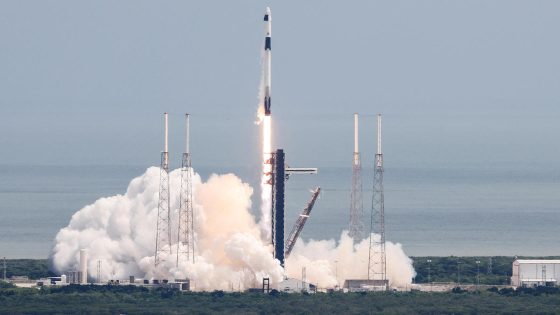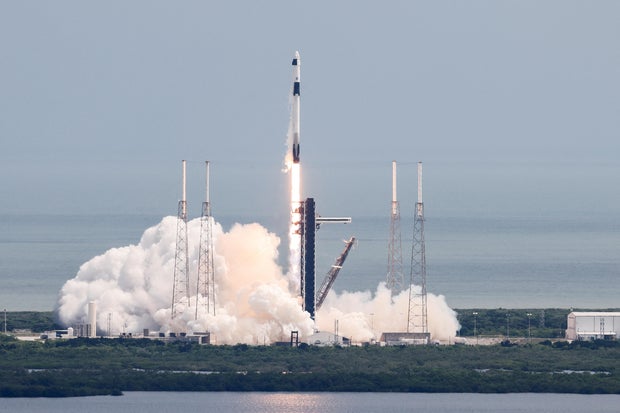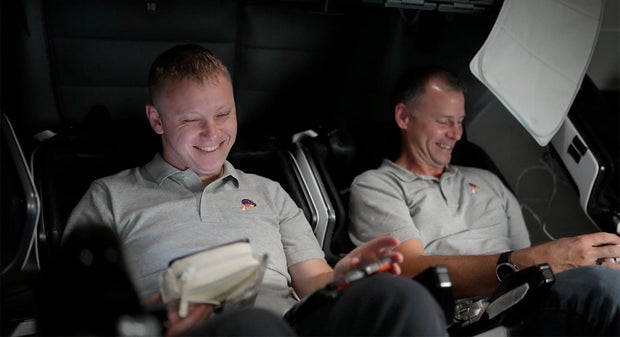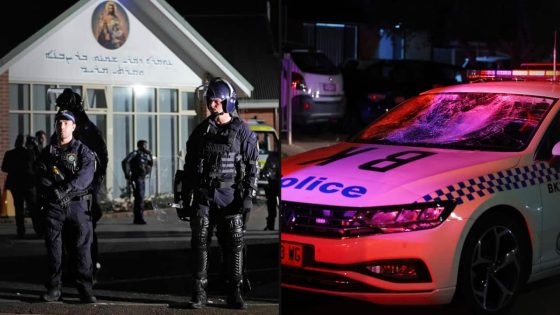SpaceX launched a reduced two-man crew on a flight to the International Space Station Saturday, along with supplies and a pair of empty seats for two Starliner astronauts waiting to hitch a ride home in February after an unexpected eight-and-a-half-month stay in orbit.
Running two days late because of high winds, rain and clouds spawned by Hurricane Helene, the SpaceX Falcon 9 rocket roared to life and blasted off from pad 40 at the Cape Canaveral Space Force Station at 1:17 p.m. EDT, climbing away on a northeasterly trajectory directly into the plane of the space station’s orbit.
Joe Skipper / REUTERS
Monitoring the automated ascent from inside the Crew Dragon “Freedom” were commander Nick Hague, a veteran NASA astronaut, and Russian cosmonaut Alexander Gorbunov, making his first flight.
Crew Dragons normally launch with four crew members, but two Crew 9 astronauts — Stephanie Wilson and Zena Cardman, the original commander — were removed from the flight in August to free up seats that will be used by Starliner commander Barry “Butch” Wilmore and pilot Sunita Williams when the Crew Dragon returns to Earth in February.
Saturday’s launch was the first piloted space flight from the Space Force Station since the early days of the Apollo moon program and the first ever for SpaceX, which launched 14 previous Crew Dragon missions from historic pad 39A at the nearby Kennedy Space Center.
After boosting the Falcon 9 out of the dense lower atmosphere, the first stage, making its second flight, flew itself back to landing at the Space Force station seven minutes and 40 seconds after liftoff.
Four-and-a-half minutes after that, the Crew Dragon was released to fly on its own, kicking off a 28-hour rendezvous with the International Space Station. If all goes well, the spacecraft will dock at the lab’s forward port at 5:30 p.m. Sunday.
NASA/SpaceX
Standing by to welcome Hague and Gorbunov aboard are Wilmore and Williams, now serving as commander of the space station, along with Soyuz MS-26/72S commander Aleksey Ovchinin, Ivan Vagner and NASA astronaut Don Pettit, who were launched Sept. 11
Hague, Gorbunov, Wilmore and Williams will take the places of Crew 8 commander Matthew Dominick, Mike Barratt, Jeanette Epps and cosmonaut Alexander Grebenkin, who were launched March 3 and will return to Earth around Oct. 7 to wrap up a 217-day stay in space.
Along with bringing Hague and Gorbunov to the station, the Crew Dragon also was packed with clothing and supplies for Wilmore and Williams, who were launched June 5 on the Starliner’s first piloted test flight.
The mission initially expected to last eight to 10 days, but multiple helium leaks in the Starliner’s propulsion system, along with degraded thrust in five maneuvering jets, eventually led to a NASA decision to bring the spacecraft down earlier this month without its crew.
Instead, NASA managers opted to launch the Crew 9 Dragon with just two of its original crew members to enable the ship to bring Wilmore and Williams back to Earth at the end of its mission in February. By the time they land aboard the Crew 9 capsule around Feb. 22, they will have logged more than 262 days in space.
NASA
Some have called the Crew Dragon flight a “rescue” mission. But Wilmore and Williams have always had a way home, first aboard their own spacecraft, then aboard the Crew 8 Dragon and, after docking Sunday, aboard the Crew 9 Dragon. NASA chose the latter option as the least disruptive to the ISS crew rotation schedule.
During a post-launch news conference, Sarah Walker, director of Dragon mission management for SpaceX, took a moment to say that “at SpaceX, we were all cheering on our NASA and our Boeing friends for a successful CFT (Crew Flight Test) mission.”
“Bringing new human spaceflight capabilities is exciting, but these early test flights come with lessons learned, always,” she said. “We still learn something every single time we fly. We’ve had our share of hardware challenges.”
The transition from a four-person crew to just two presented a different sort of challenge for Hague and Gorbunov — as well as for Wilmore and Williams — who never trained for a flight aboard a Crew Dragon.
“We’re going to launch as a two-person crew, and then we’re going to land as a four-person crew,” Hague said. “And one of the unique challenges of that is, how do we integrate the other two crew members into the Dragon operations when they’ve had very minimal Dragon training before they launched?
“The teams on the ground have helped not only get us ready, but they’ve already started helping Butch and Suni train to understand what they’re going to need to do inside of inside of the Dragon. That’s going to be top priority when we get there, (helping) them understand what they’re going to need to do to operate as part of the Crew 9 crew.”
NASA
Hague is a Space Force colonel, a former F-16 test pilot and combat veteran who logged 203 days in space on an earlier mission. He also went through a dramatic in-flight abort during launch aboard a Russian Soyuz spacecraft in 2018. His range of experience presumably played a major role in NASA’s decision to move him into the commander’s seat for the revised mission.
Gorbunov kept his seat aboard the Crew 9 Dragon under a contract between NASA and Roscosmos, the Russian federal space agency, in which three-seat Russian Soyuz spacecraft carry one NASA astronaut on each flight to the ISS and a cosmonaut launches on each four-seat Crew Dragon.
That ensures each country always has at least one crew member on board the lab even if an emergency forces one ferry ship and its crew to make an unplanned return to Earth. Gorbunov is not trained to serve as a Crew Dragon pilot, but he will be sitting in the pilot’s seat during launch to assist Hague.
“Essentially, we’re flying without a pilot, and so fundamentally, the commander is responsible for keeping the crew safe, keeping the vehicle safe and making sure we get the mission done,” Hague said. “And so those responsibilities haven’t changed.
“Alex is going to be working to support me during all the dynamic phases of flight and provide me with the extra set of eyes, the extra set of hands that I would need and that I would leverage if I had a pilot sitting next to me. So in that way, it’s not very different.”
Source Agencies






